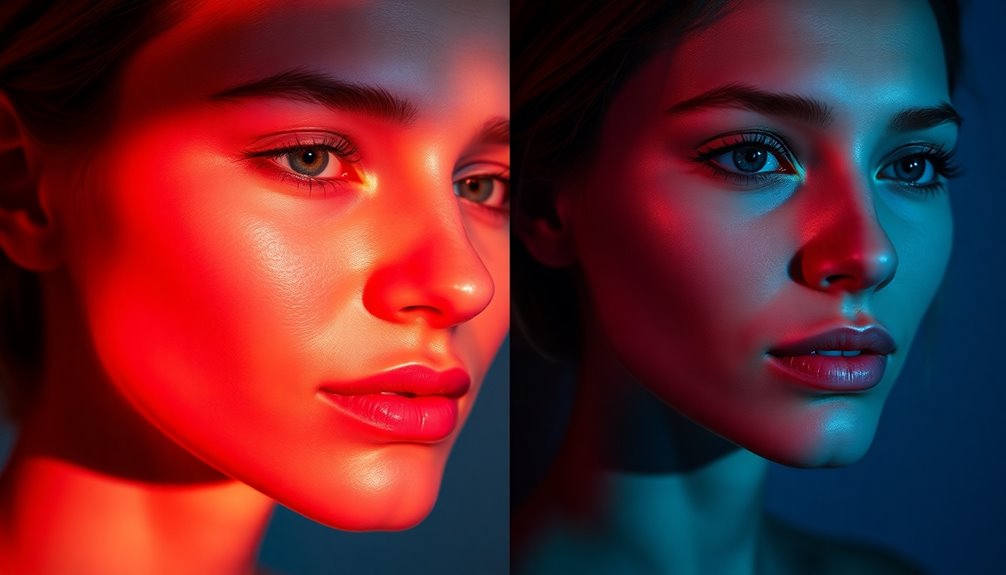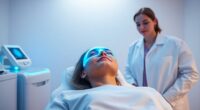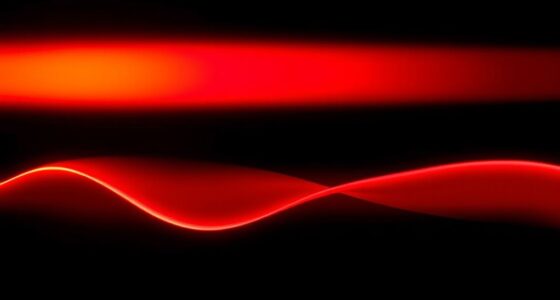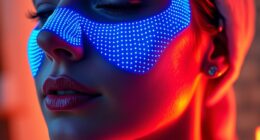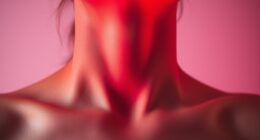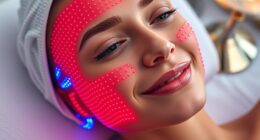When choosing between red light and blue light for your skin, consider your specific needs. If you're battling acne, blue light is your best bet as it targets and kills acne-causing bacteria. On the other hand, if you want to reduce signs of aging, red light excels at stimulating collagen production and improving skin elasticity. Both have unique advantages and can even be combined for enhanced results. Depending on your skin concerns and goals, one might suit you better. There's plenty more to uncover about how each light can benefit your skincare routine.
Key Takeaways
- Red light therapy boosts collagen production and improves skin elasticity, making it suitable for anti-aging and reducing fine lines.
- Blue light therapy effectively targets acne by killing acne-causing bacteria and preventing future breakouts.
- Dual light therapy combines the benefits of both red and blue light, addressing acne while promoting skin rejuvenation and reducing hyperpigmentation.
- Red light is ideal for enhancing skin tone and texture, while blue light focuses on treating active acne lesions.
- Consult a dermatologist to determine the best treatment for your specific skin concerns and goals.
Understanding Light Therapy
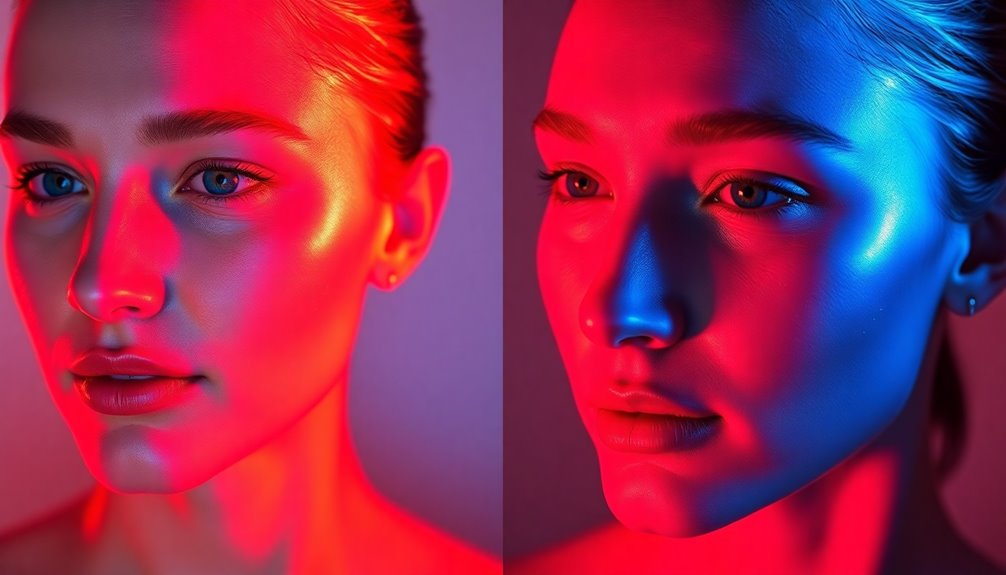
Light therapy has gained popularity for its ability to address various skin concerns, especially acne. This treatment utilizes different wavelengths of light, with blue light being particularly effective in targeting acne breakouts. The non-surgical, minimally invasive procedure typically offers quick sessions that fit easily into your schedule. You can expect noticeable improvements in skin texture and overall clarity, as studies have shown significant reductions in acne lesions. Blue light therapy is known for its precise targeting of specific areas of concern, ensuring effective treatment.
At your appointment, you'll need clean, makeup-free skin, and eye protection is essential. While side effects like temporary redness, mild swelling, and increased sensitivity to sunlight may occur, they usually resolve quickly.
Following your dermatologist's post-treatment care advice can help maintain your results and maximize the benefits of blue light therapy.
Red Light Therapy Benefits
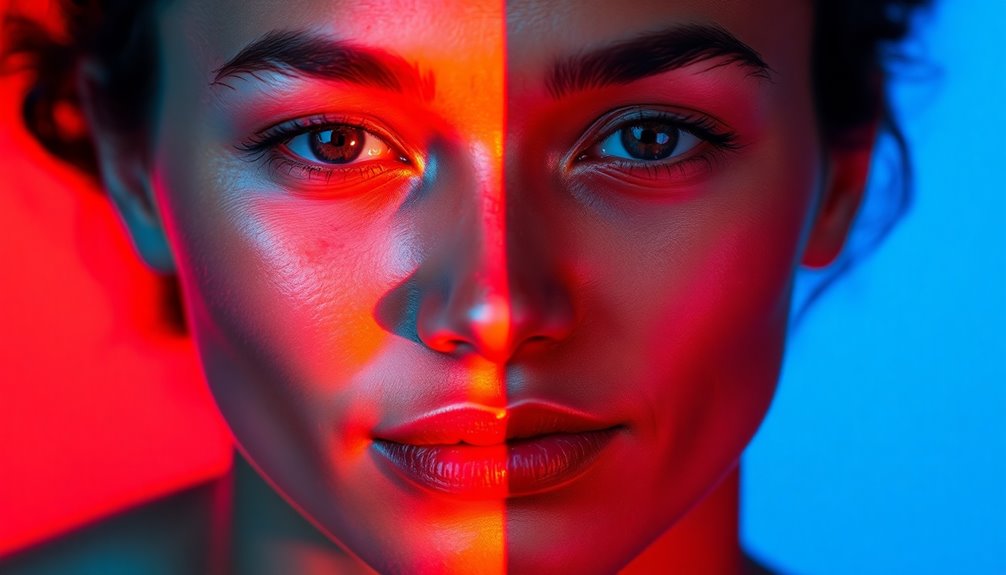
Red light therapy offers a range of benefits for your skin and overall well-being. It stimulates collagen production, helping improve skin elasticity while reducing fine lines and wrinkles.
You'll notice an enhancement in skin tone and texture, and it may even assist in treating acne and other skin conditions. Additionally, early evidence supports RLT's role in acne management, with potential for enhanced results through combined therapies.
Beyond skin rejuvenation, red light therapy accelerates wound healing by promoting tissue repair and reducing inflammation.
It also supports pain management by alleviating discomfort from conditions like arthritis and muscle soreness.
Additionally, if you're looking to boost hair growth, this therapy can activate hair follicles and improve blood circulation, providing the necessary cellular energy to support healthy hair development.
Embracing red light therapy could be a game-changer for you!
Blue Light Therapy Benefits
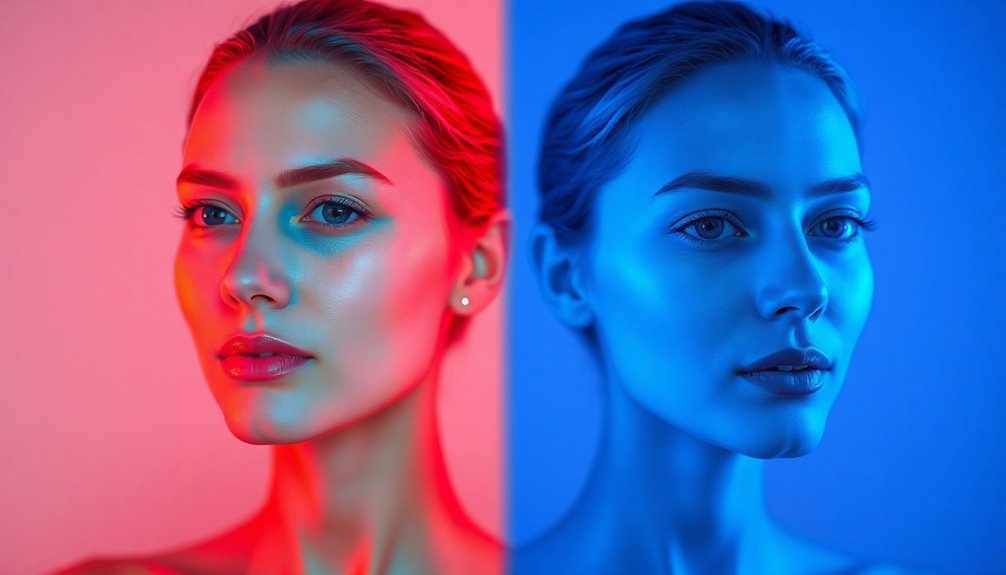
If you're dealing with acne or looking to rejuvenate your skin, blue light therapy could be the solution you've been searching for. This effective treatment targets and reduces acne breakouts by killing acne-causing bacteria quickly and conveniently.
You can enjoy customized sessions that focus on specific areas of concern, making it a precise solution tailored to your needs.
Beyond acne, blue light therapy promotes overall skin rejuvenation, enhancing texture and clarity while reducing signs of aging. As a non-surgical and minimally invasive procedure, it offers quick results and minimal downtime, allowing you to return to your daily activities almost immediately. Additionally, blue light therapy effectively targets surface bacteria to prevent future breakouts.
Whether it's fine lines or sun-damaged skin, blue light therapy supports faster healing for healthier-looking skin.
Mechanism of Action
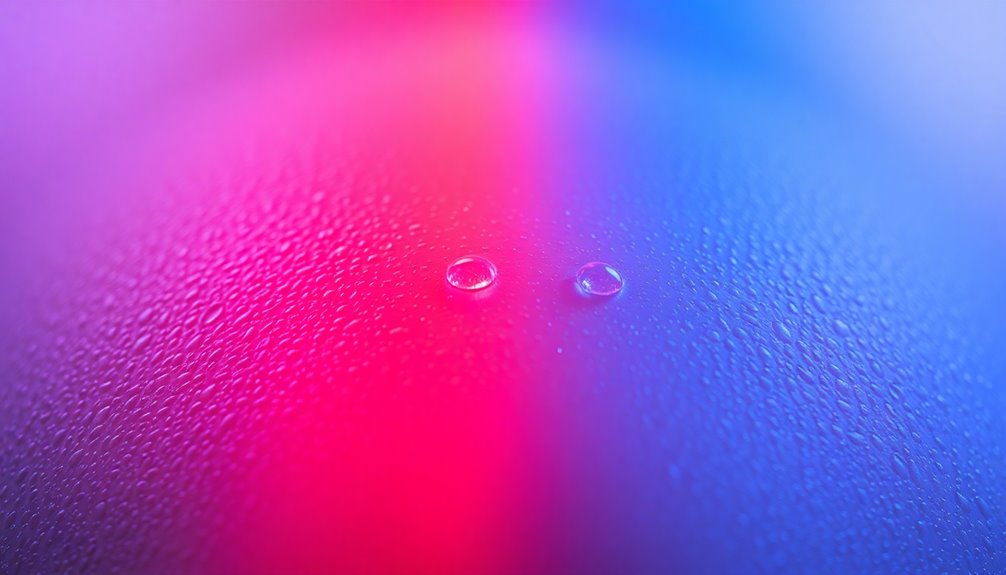
Numerous studies have highlighted the powerful mechanisms behind red light therapy's effectiveness for skin rejuvenation.
This therapy stimulates collagen production, enhancing skin elasticity while reducing fine lines and wrinkles. By activating fibroblasts, it promotes tissue repair and improves overall skin texture.
Red light also reduces inflammation, helping treat conditions like psoriasis and atopic dermatitis. It boosts cellular energy by increasing ATP production, allowing cells to better respond to damage. Furthermore, this therapy's use of light in the range of 600 to 1,000 nanometers enhances its ability to penetrate the skin effectively.
Additionally, red light encourages cell proliferation and angiogenesis, which aids in healing. Lastly, it modulates immune responses, enhancing the skin's defense mechanisms.
With these combined effects, red light therapy offers a comprehensive approach to achieving healthier, rejuvenated skin.
Skin Layers Affected
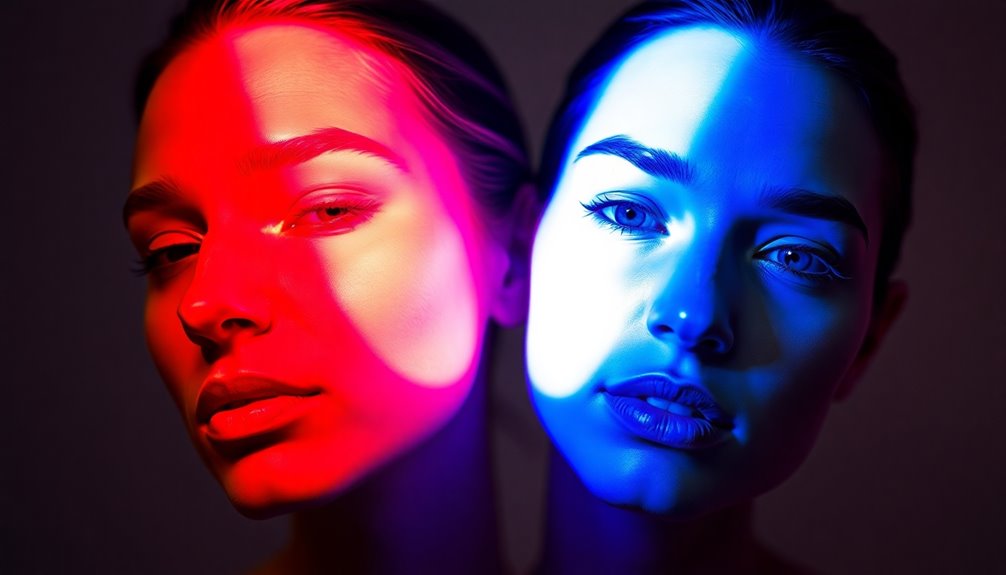
Understanding the mechanisms of action behind light therapies sets the stage for exploring how these treatments affect different skin layers.
Red light primarily targets the dermis, stimulating collagen production that enhances elasticity and firmness. It effectively reduces wrinkles and fine lines while alleviating inflammation, making it beneficial for conditions like acne and rosacea. Additionally, red light accelerates cellular turnover and promotes healing of wounds and scars. This light therapy is also known for its anti-inflammatory properties, which further supports skin recovery. Moreover, incorporating essential oils into skincare routines can complement the benefits of red light therapy.
On the other hand, blue light focuses on the epidermis, specifically targeting acne-causing bacteria. It reduces inflammation and helps clear up acne symptoms.
Blue light also controls melanin production, minimizing pigmentation issues, and supports faster healing by creating a healthier skin environment. Each light serves distinct purposes based on the skin layers they affect.
Unique Advantages of Red Light
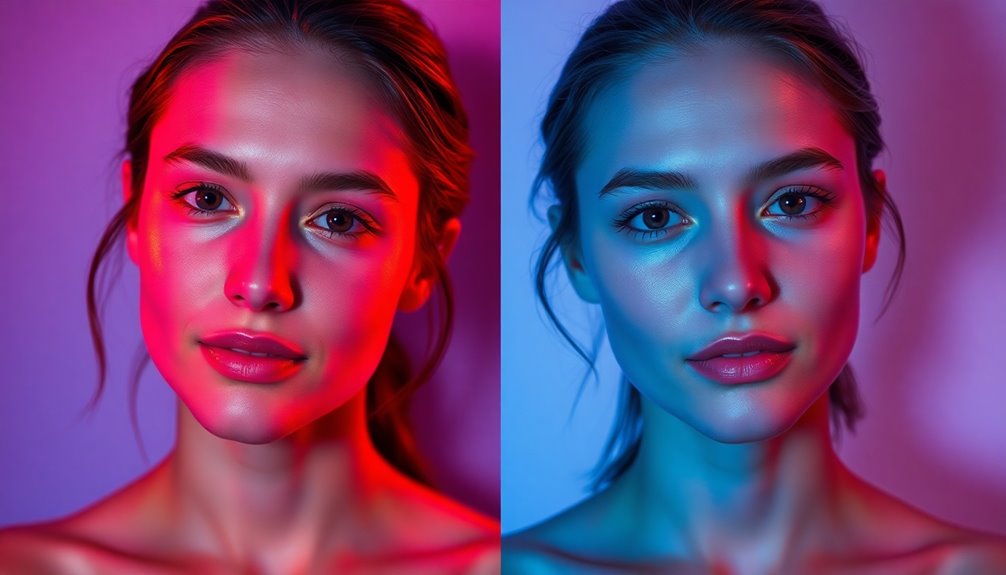
While both red and blue light therapies offer significant benefits, red light stands out due to its unique advantages for skin health.
It penetrates deep into your skin, reducing inflammation and stimulating collagen production, which improves texture and reduces wrinkles. You'll notice enhanced skin regeneration as red light encourages elastin production.
Plus, it boosts mitochondrial activity, increasing cellular energy and enhancing healing processes. This means quicker wound healing and less acne severity. Recent studies have shown that self-administered devices can achieve a 70% reduction in inflammatory acne for users.
Red light also helps reduce signs of aging, improves skin tone, and decreases scar appearance.
It's safe, non-invasive, and easy to use, making it a quick solution for rejuvenating your skin and promoting elasticity without any downtime.
Unique Advantages of Blue Light
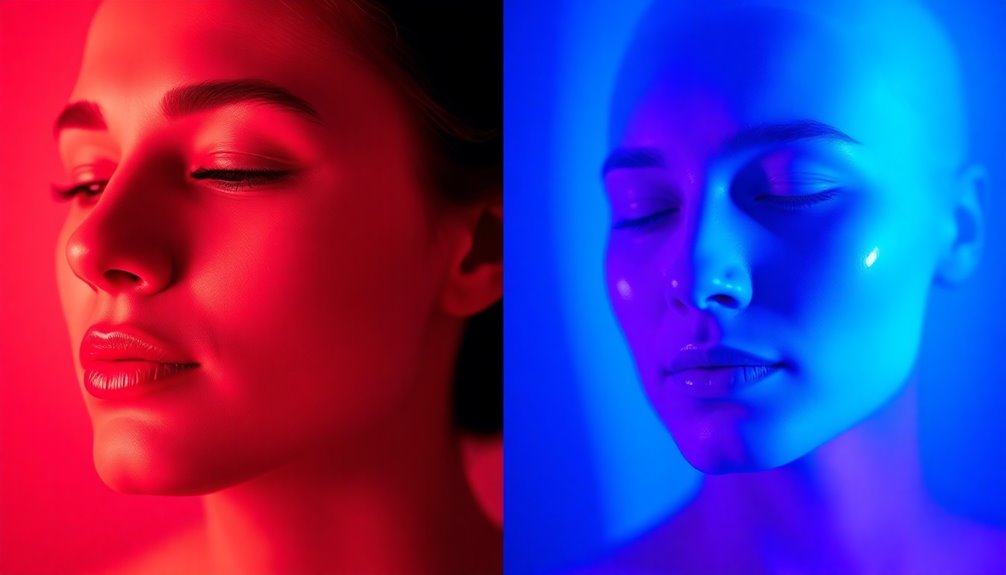
Blue light therapy offers several unique advantages for skin health, particularly in treating acne and enhancing overall skin rejuvenation.
It specifically targets acne-causing bacteria, reducing inflammation and preventing future breakouts without invasive procedures or harsh chemicals. You'll appreciate how quick and convenient the sessions are, delivering efficient results.
Additionally, blue light stimulates collagen production, improving skin elasticity and texture while aiding in wound healing. Its antimicrobial properties effectively eliminate pathogens, making it beneficial for conditions like eczema and psoriasis. This treatment is especially effective against antibiotic-resistant bacteria, ensuring a broader range of efficacy.
Plus, blue light reduces inflammation and soothes sensitive skin, providing much-needed relief.
Combination Therapy Benefits
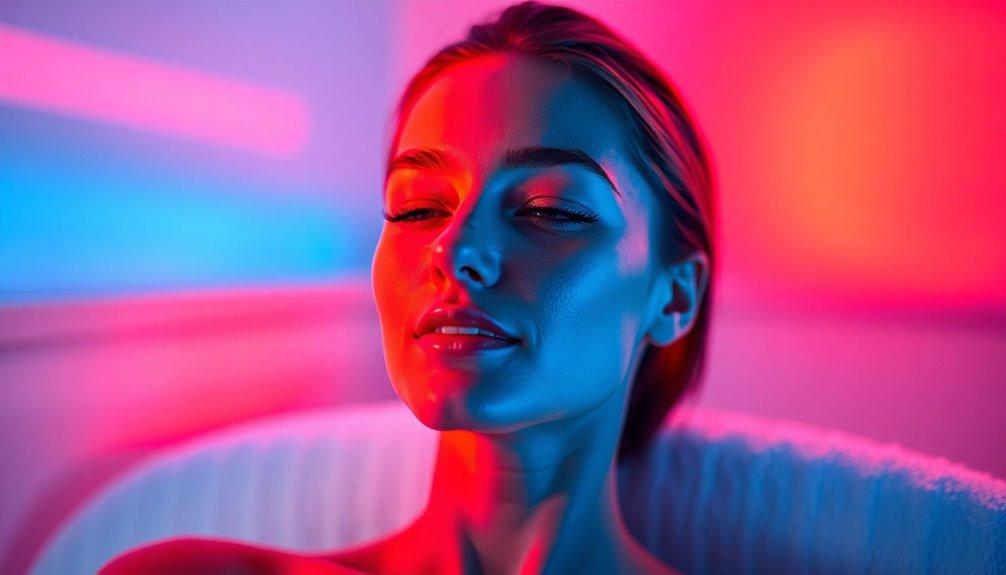
Combining red and blue light therapies can maximize skin benefits, providing a powerful approach to various skin concerns. This dual therapy stimulates collagen production and enhances cellular turnover, promoting healthier skin. As circulation improves, skin oxygenation increases, leading to a smoother, more even tone. The combination effectively combats acne by targeting bacteria and reducing inflammation, making it ideal for various conditions like rosacea and eczema. It also tackles hyperpigmentation, helping diminish dark spots. Additionally, this therapy is known to be suitable for all ages and skin types, ensuring that anyone can benefit from its effects. Plus, the accelerated healing process reduces scarring and promotes a youthful appearance. By addressing multiple skin issues simultaneously, this combination therapy not only enhances your skin's texture but also prevents future breakouts, giving you that radiant glow you desire.
Choosing the Right Light
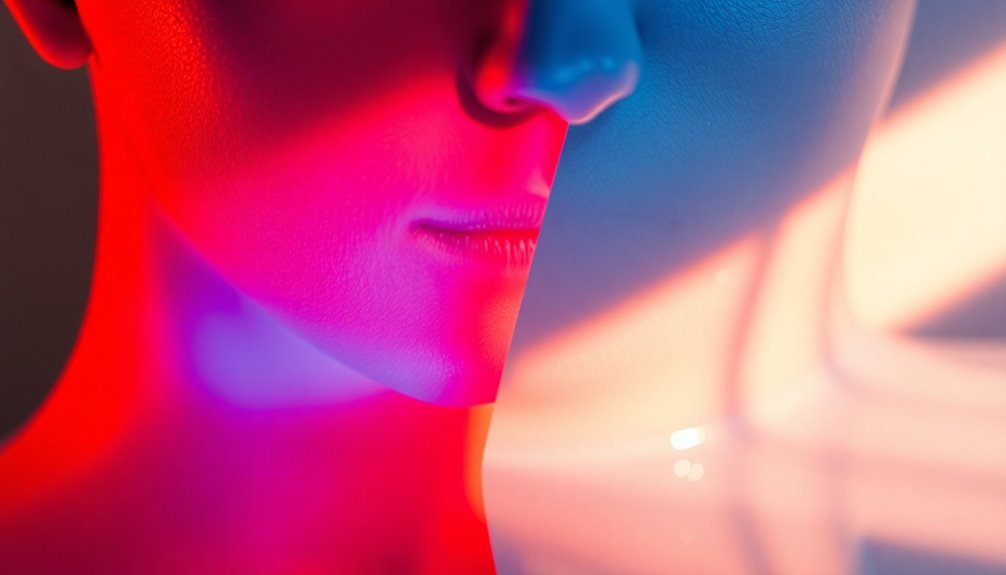
When it comes to selecting the right light therapy for your skin concerns, understanding your specific needs is essential.
If you struggle with acne, blue light can effectively target acne-causing bacteria, while red light is ideal for anti-aging, boosting collagen and reducing wrinkles.
For hyperpigmentation, both lights can help even skin tone.
If you have eczema or inflammation, consider red light for deeper penetration and healing. Incorporating LED therapy consistently into your routine can enhance overall effectiveness.
When choosing a device, think about your skin type, desired intensity, and treatment duration.
Look for features like adjustable settings, timers, and interchangeable heads for personalized care.
Consulting dermatologists can also guide you to the best options tailored to your needs, ensuring you get the most effective treatment possible.
At-Home Treatment Options
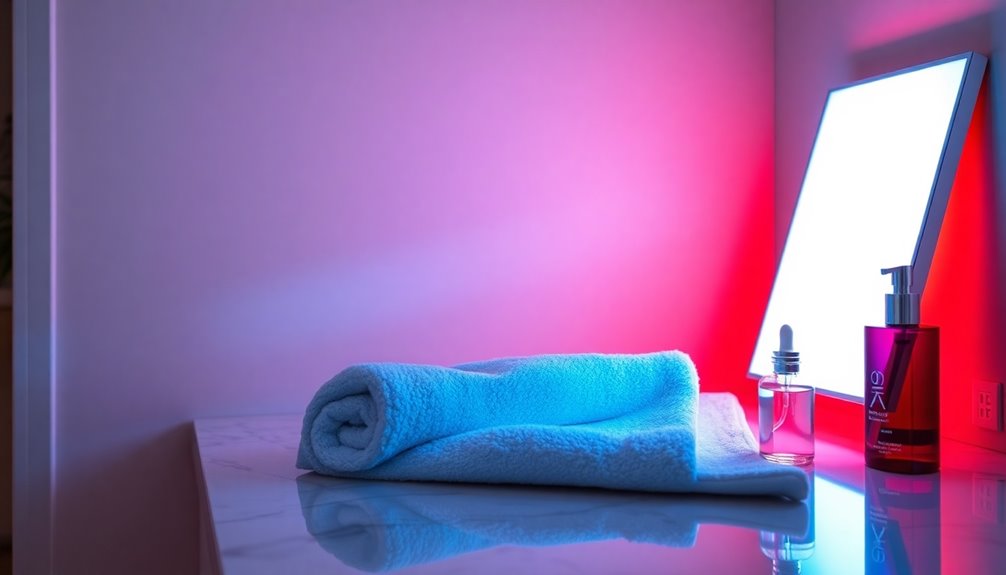
If you're looking to enhance your skincare routine, at-home light therapy options can be a game-changer.
Red light therapy reduces wrinkles, improves skin elasticity, and boosts collagen production. You can find devices on platforms like Amazon and Sephora, typically using wavelengths around 660 nanometers. For best results, use it daily alongside your skincare products. Additionally, clinical trials indicate that red light therapy can lead to significant improvement in skin texture and tone.
On the other hand, blue light therapy targets acne-causing bacteria, reduces oil production, and helps control breakouts. Available in similar retail outlets, these devices use blue LED light around 415 nanometers.
They can be used alone or combined with red light therapy for comprehensive care. Always remember to be patient; consistent use is key to achieving noticeable results.
Frequently Asked Questions
Can I Use Both Red and Blue Light Therapies Together?
Imagine your skin basking in the best of both worlds! Yes, you can absolutely use both red and blue light therapies together.
This combo works wonders by tackling acne and boosting collagen production simultaneously. Red light penetrates deeper, promoting healing, while blue light zaps bacteria at the surface.
For a balanced approach, this powerful duo can enhance your skin's texture and overall health. Just remember to consult a dermatologist for personalized advice!
How Often Should I Use Light Therapy for Best Results?
To get the best results from light therapy, aim for daily use or at least three times a week. Consistency is crucial for long-term skin improvements.
For general skin health, shorter sessions are typically enough, while specific skin issues might require longer sessions. Once you achieve your desired results, maintain your skin with 2-3 sessions weekly.
Are There Any Side Effects of Using Light Therapy?
Using light therapy can feel like walking a tightrope; while it offers benefits, side effects do exist.
You might experience increased inflammation, redness, or even a rash. Pain and dryness can also occur, so it's crucial to monitor your skin.
To minimize risks, avoid bright light during treatment and consult a dermatologist for tailored advice.
Can Light Therapy Treat Other Skin Issues Besides Acne and Aging?
Yes, light therapy can treat various skin issues beyond acne and aging.
You might find that red light therapy helps with scarring, hyperpigmentation, and rosacea by promoting collagen production and improving skin texture.
On the other hand, blue light therapy targets acne-causing bacteria and can reduce inflammation.
Combining both can enhance results, addressing multiple concerns simultaneously, while improving overall skin tone and promoting healing.
Always consult a dermatologist for personalized advice.
Is Light Therapy Safe for All Skin Types?
Yes, light therapy is generally safe for all skin types.
It's a non-invasive and painless treatment that doesn't use UV light, so it won't burn or damage your skin.
While side effects like redness or tenderness can occur, they're rare.
Always consult a dermatologist before starting treatment, especially if you're on medication or have specific skin conditions.
They'll help determine if light therapy is right for you and guide you on the best approach.
Conclusion
In the end, both red and blue light therapies have unique benefits for your skin. While you might worry about choosing the right one, remember that combining both can maximize your results. Red light boosts collagen and healing, while blue light targets acne-causing bacteria. By understanding your skin’s needs, you can effectively harness the power of light therapy. So go ahead, explore your options, and find the perfect treatment to brighten and rejuvenate your complexion! Additionally, many skincare professionals recommend using these therapies in tandem to take advantage of the synergistic effects they offer. By embracing the benefits of red and blue light therapy, you can achieve a more comprehensive approach to skin care that addresses multiple concerns at once. Ultimately, investing time in these treatments can lead to a brighter, healthier complexion that reflects your inner vitality.
